Potřebujeme váš souhlas k využití jednotlivých dat, aby se vám mimo jiné mohly ukazovat informace týkající se vašich zájmů. Souhlas udělíte kliknutím na tlačítko „OK“.
ASTM E1744-04(2010)
Standard Practice for View of Emergency Medical Care in the Electronic Health Record (Withdrawn 2017)
Automaticky přeložený název:
Standardní praxe pro Pohled na neodkladné zdravotní péče v elektronického zdravotního záznamu
NORMA vydána dne 1.3.2010
Informace o normě:
Označení normy: ASTM E1744-04(2010)
Poznámka: NEPLATNÁ
Datum vydání normy: 1.3.2010
Kód zboží: NS-42857
Počet stran: 27
Přibližná hmotnost: 81 g (0.18 liber)
Země: Americká technická norma
Kategorie: Technické normy ASTM
Kategorie - podobné normy:
Anotace textu normy ASTM E1744-04(2010) :
Keywords:
computer-based patient record, emergency department data set, emergency medical care, inpatient data set, pre-hospital EMS data set, Computer-based patient record (CPR), Data analysis--medical applications, Emergency medical services (EMS), Patient biographical/medical data, ICS Number Code 35.240.80 (IT applications in health care technology)
Doplňující informace
| Significance and Use | ||||||||||||||||||||||||
|
The Emergency Medical Service System (EMSS) in the United States has largely arisen since 1945 and has drawn to a great degree from the experience gained in military conflicts during and since World War II. The documentation of care, however, has remained largely paper record–based until recently. Beginning in the 1970s both civilian and military agencies have closely examined electronic means of storing and managing patient data about emergency medical care. The report of the Institute of Medicine on the Computer-Based Patient Record has emphasized the use of information technology in patient care in general and emergency care data in particular. During this period ASTM has documented the logical structure of the electronic health record in Guide E1239 and Practice E1384, while Guides F1288 and F1629 has defined the patient care data, to be gathered in the pre-hospital record, and the outcome data, relative to the pre-hospital phase of the emergency, which are collected in the emergency department and after inpatient admission. Specifications for the logical model are also presented in Practice E1715. This practice shows how the data gathered for EMS operations and management merge smoothly into the computer-based patient record, consistent with the recognition that these data are part of the primary record of care. Several states have formalized that recognition in state law. This practice does not instruct physicians how to collect data for patient care. This practice does not indicate what information needs to be collected at the time of patient care. The task now is to document, using standard conventions, the means by which this integration occurs in order to set the stage for the capture and transfer of such emergency care data using information technology and telecommunications in a standardized way consistent with all other settings of care while protecting the privacy and confidentiality of that data. The electronic health record has the potential to reduce health care costs by optimizing case management and supporting effective post ED follow-up. Systematizing the data also enhances its ability to be used consistently, with proper protection, for research into and for management of EMSS operations within the various jurisdictional boundaries. The electronic form of the emergency episode documentation utilizes the same logical data model as the electronic health record, but it focuses on data collected during the different phases of the emergency. These data sets do not limit what may be recorded, or by whom, but they do identify those data considered essential, when they exist. These data sets include all those data recorded to document instances of emergency medical care. Data organized to enhance flexible and efficient management of information. Identifications of practitioners and facilities will be coded, when necessary, to protect confidentiality and to make provider data comparable. Names will be included when they are necessary to support patient care. Privacy and confidentiality of patient data should be handled according to Guide E1869. Provider identification numbers will be maintained on master data files which also include additional information such as specialty, license level, and the like. Provider identification numbers recorded in the electronic health record will automatically link to the master data files to eliminate the need for duplicate data entry of reference material in the patient record. Coding systems for emergency reporting (ICD-9-CM, CPT, HCPCS, SNOMED ) will be referenced in the master data files for Practice E1384 as appropriate. The efficient arrangement of the logical model of Practice E1384 permits output to be generated and identified to mirror the paper record, such as nurse-specific or physician-specific notes. The arrangement of the logical model permits multiple entries of assessment data, using a small group of variables, that can then be used to generate output. For example, sequence of diagnoses by date-time. |
||||||||||||||||||||||||
| 1. Scope | ||||||||||||||||||||||||
|
1.1 This practice covers the identification of the information that is necessary to document emergency medical care in an electronic, paperless patient record system that is designed to improve efficiency and cost-effectiveness. 1.2 This practice is a view of the data elements to document the types of emergency medical information that should be included in the electronic health record. 1.2.1 The patient's summary record and derived data sets will be described separately from this practice. 1.2.2 As a view of the electronic health record, the information presented will conform to the structure defined in other ASTM standards for the electronic health record. 1.3 This practice is intended to amplify Guides E1239 and F1629 and the formalisms described in Practices E1384 and E1715. 1.3.1 This practice details the use of data elements already established in these standards and other national guidelines for use during documentation of emergency care in the field or in a treatment facility and places them in the context of the object models for health care in Practice E1384 that will be the vehicle for communication standards for health care data. 1.3.1.1 The data elements and the attributes referred to in this practice are based on national guidelines whenever available. 1.3.1.2 The EMS definitions are based on those generated from the previous EMS consensus conference sponsored by NHTSA and from ASTM task group F 30.03.03 on EMS Management Information Systems. 1.3.1.3 The Emergency Department (ED) definitions are based on the Data Elements for Emergency Department Systems (DEEDS) distributed by the Centers for Disease Control in June 1997. 1.3.1.4 The hospital discharge definitions are based on recommendations from the Centers for Medicare and Medicaid Services (CMS) for Medicare and Medicaid payment and from the Department of Health and Human Services for the Uniform Hospital Discharge Data Set. 1.3.1.5 Because the current trend is to store data as text, the codes for the attribute values have been determined as unnecessary and thus are eliminated from this document. 1.3.1.6 The ASTM process allows for the data elements to be updated as the national consensus changes. When national or professional guides do not exist, or whenever there is a conflict in the existing EMS, ED, hospital or other guides, the committee will recommend a process for resolving the conflict or an explanation of the conflict within each guide. 1.3.2 This practice reinforces the concepts set forth in Guide E1239 and Practice E1384 that documentation of care in all settings shall be seamless and be conducted under a common set of precepts using a common logical record structure and common terminology. 1.4 The electronic health record focuses on the patient. 1.4.1 In particular, the computer–based patient record sets out to ensure that the data document includes: 1.4.1.1 The occurrence of the emergency, 1.4.1.2 The symptoms requiring emergency medical treatment, and potential complications resulting from preexisting conditions, 1.4.1.3 The medical/mental assessment/diagnoses established, 1.4.1.4 The treatment rendered, and 1.4.1.5 The outcome and disposition of the patient after emergency treatment. 1.4.2 The electronic health record consists of subsets of data for the emergency patient that have been captured by different care providers at the time of treatment at the scene and en route, in the emergency department, and in the hospital or other emergency health care settings. 1.4.3 The electronic record focuses on the documentation of information that is necessary to support patient care but does not define appropriate care. |
||||||||||||||||||||||||
| 2. Referenced Documents | ||||||||||||||||||||||||
|
Podobné normy:
Historická
15.6.2012
Historická
1.6.2013
Historická
1.3.2013
Historická
1.3.2013
Historická
1.4.2014
Historická
1.6.2009
Doporučujeme:
Aktualizace technických norem
Chcete mít jistotu, že používáte pouze platné technické normy?
Nabízíme Vám řešení, které Vám zajistí měsíční přehled o aktuálnosti norem, které používáte.
Chcete vědět více informací? Podívejte se na tuto stránku.


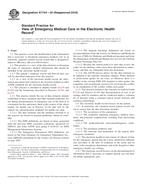
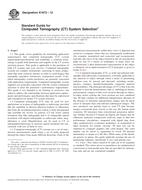 ASTM E1672-12
ASTM E1672-12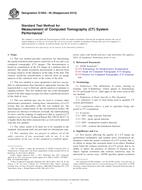 ASTM E1695-95(2013)..
ASTM E1695-95(2013)..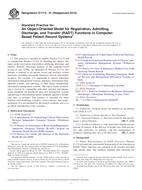 ASTM E1715-01(2013)..
ASTM E1715-01(2013).. ASTM E1762-95(2013)..
ASTM E1762-95(2013)..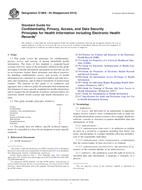 ASTM E1869-04(2014)..
ASTM E1869-04(2014)..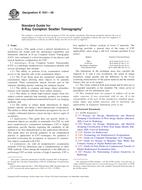 ASTM E1931-09
ASTM E1931-09
 Cookies
Cookies
